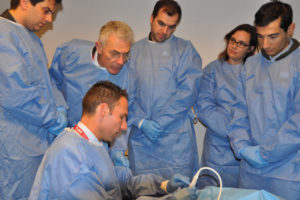There is an explosion of interest in transradial access within interventional radiology. With the twitterverse abuzz with hashtags such as #radialfirst and #transradial and physicians stating that the best way to a person’s heart is through their radial artery, Interventional News spoke to two proponents of the radial revolution, Darren Klass and Aaron Fischman, about what we need to know in 2017.
Klass is an interventional radiologist at Vancouver Imaging, Vancouver, Canada and Fischman is an interventional radiologist with the Department of Radiology, Icahn School of Medicine at Mount Sinai, New York, USA.
“Radial intervention is not a religion; the patient is central, not the procedure. [But] This is a technique that should be practiced by all interventional radiologists, because it is better for patients,” Klass said.
What is the most interesting piece of research you have come across recently about radial access?

DK: The most interesting research in my opinion is within the cardiology literature; however, the findings are extremely important and pertinent to our specialty. PROPHET II was a randomised controlled trial of 3,000 patients comparing patent haemostasis with and without ipsilateral ulnar artery compression. The rates of radial artery occlusion at 30 days were significantly lower in the group where patent haemostasis and ulnar artery compression was used. This has changed my practice and although our centre, after over 1,200 cases, has an extremely low asymptomatic occlusion rate, my aim with every access is to ensure, as much as possible, that the vessel is spared for subsequent interventions. The theory of ulnar artery compression during patent haemostasis allows increased flow through the radial artery thus decreasing occlusion rates. The ulnar artery is not accessed and, therefore, temporary compression does not cause occlusion.
Within the interventional radiology space, Marcelo Guimaraes (Medical University of South Carolina) is conducting an extremely interesting prospective study assessing patient preference for transarterial chemoembolization (TACE), and I eagerly await the result.
AF: The PROPHET II study by Pancholy et al. was very interesting because in a randomised fashion they were able to show a significant decrease in radial artery occlusion with prophylactic ipsilateral ulnar compression during radial artery haemostasis. The primary endpoint of 30-day radial artery occlusion was 0.9% with ulnar compression vs. 3% in the control arm. Despite the fact that this is a cardiology study, I think this has implications for interventional radiology. Radial artery occlusion is not very common in my practice, but does occur in small numbers. This technique could virtually eliminate that in certain high risk cases.
What is the most interesting radial access research that you are carrying out?
DK: We have just completed data analysis of a rapid haemostasis protocol named PROTEA (Percutanous radial haemostasis using a truncated deflation algorithm), which will be presented at SIR 2017. This protocol uses a proprietary haemostasis pad (Statseal, Biolife) to aid with haemostasis during deflation of the balloon. The protocol decreases the haemostasis time to 25 minutes (from an hour, or more) in patients undergoing procedures with a 7F sheath or less and no more than 5000IU heparin. This has dramatically improved patient discharge times, and our centre now has an 85% TACE out-patient service where patients are discharged within 90 minutes of coming off the angiography table.

AF: Right now, we are designing a randomised trial for interventional oncology patients. Specifically, quality of life (QOL) and patient satisfaction is of great interest to me. We plan to take a patient population that has multiple procedures in a short period of time such as Y-90 and randomise them to femoral or radial access and then use the opposite technique for their second procedure. Using validated survey mechanisms, we are going to determine if patients are more satisfied with radial or femoral access. QOL is something that is provable in interventional radiology with smaller numbers of patients.
Within the interventional radiology world, what is the response to hands-on learning and workshops in this area?
DK: The response has been excellent and I believe this is echoed by all of my colleagues who train interventional radiologists in this technique. The most important message is that this is not just an access procedure and it involves the training of paramedical staff and having tools to be able to complete cases and tips for challenging cases. I am asked all the time if it is necessary to attend a course before offering this service; I think it is absolutely necessary. The training provides not only access and haemostasis, but also addresses complications, pitfalls and inventory needed for complex cases. You can learn this yourself but I do not believe if you have access to training, that patients should be put at risk while you work things out for yourself when you can be provided all the tools to do this.
I have given advice to many interventionists once they begin using this approach. The most common questions are often around difficult cases or non-specific symptoms after the case, where patients may present with pins and needles in the hand and operators are unsure as to the approach to deal with these issues. The answer is often a simple one, but you need the tools to be able to manage these issues and the courses and workshops provide them.
AF: I have organised and co-ordinated many hands-on workshops regarding radial access over the years. They are often well attended and of great interest to the interventional community. The radial approach is not a new concept but for interventional radiologists it can be intimidating if the tips and tricks are unfamiliar. When I teach these courses I tend to focus proper technique. If proper technique is followed from the beginning, success rates are much higher.
What would be your most compelling argument to a staunch femoralist about radial access?
DK: This is a procedure that is better for patients. It allows them to ambulate much faster and is more comfortable. For oncology procedures, keeping a patient in overnight just because of a femoral puncture is not good patient care. These patients often have a few months to live and taking away a night from their loved ones just because you do not think radial access is worth learning is doing the patient a disservice.
For operators doing many peripheral vascular procedures, the argument of percutaneous brachial is not an argument. Performing a procedure on a patient with a complication rate of 12% (of which 50% require surgery) is unforgivable. It is 2017—use the radial artery.
AF: All femoralists should consider this: interventional radiology has always been about innovation, creative thought and high technical skill. Many of the procedures we do are not unique to us. What can differentiate us from other specialties is the desire to make our procedures less invasive, more patient friendly, low cost and low morbidity. The data support radial access over femoral access in all of those categories. As we create more data on the radial access technique in interventional radiology, I am confident that we will be able to easily demonstrate the value of radial access. Even the most staunch femoralists realise that there are situations where radial access is needed regardless of operator preference. It will only serve us well in the future to make sure our trainees are well versed in both techniques allowing for optimised patient care.
Are there any devices missing from the market currently?
DK: The biggest current issue is the lack of guiding catheters longer than 100cm. We need at least 115cm or 120cm guiding catheters to allow for more complex visceral work. The stent and balloon delivery systems need to be at least 150cm to allow for work through 120cm Sheathless guiding catheters and either rapid exchange systems or longer wires. Lower profile balloons and stents with technology acquired from coronary devices would be beneficial and important to allow work through as small delivery systems as possible.
AF: We are beginning to see longer diagnostic catheters ranging from 110–125cm in our labs. Microcatheter systems are generally well suited at the 150cm lengths. However, guiding catheters typically max out at 100cm length and this can be a problem when planning more complex interventions. Also, guiding sheaths are not typically hydrophillic all the way to skin entry point and this is as huge safety problem when using them in complex interventions requiring covered stents or distal peripheral arterial disease interventions. These are currently in development. Newer closure bands taking into account the findings of the PROPHET II study and others would be of tremendous value. Lastly, distal peripheral arterial disease interventions are not yet ready for primetime. Longer stent, balloon and atherectomy delivery systems would be extremely valuable in developing the peripheral arterial disease radial technique. This is currently underway and is something I am very excited about.

Radial “MasterKlass” with Darren Klass
Essential devices
Always use a sheath designed for the radial artery, there are multiple options and all come with an access needle and wire, a femoral sheath cannot be used. I use a single catheter for all of my visceral work (Ultimate 1; Merit Medical) and a 45-degree angled catheter for everything else.
The Ultimate 1 shape is mirrored by other manufacturers and is essential for visceral work. The more important aspect is catheter length. I have both 110cm and 125cm 4F and 5F radial catheters on my shelf which I use for all my cases including pelvic work (trauma, gastrointestinal bleeds and uterine fibroid embolization) and also keep a 4F and 5F 45-degree, 150cm catheters on the shelf for taller patients for pelvic work as well as proximal superficial femoral artery work. A 150cm microcatheter is also an essential.
An indispensible piece of equipment is the sheathless guide catheter range (Asahi-INTECC), which allows the operator to use large bore guiding catheters for complex procedures without having to use large sheaths. This allows for up to 8.5F guiding catheters to be used in the radial artery and opens a platform for stenting using covered self-expanding and balloon expandable stents, as well as complex balloon occlusion or multicatheter embolic protection techniques.
New radial access technique
I am working on a new technique of accessing the dorsal branch of the radial artery, proximally in the anatomical snuffbox. This technique has been well-described in Russian literature, and appears to be more comfortable for patients with an even lower rate of haematoma and bleeding than conventional radial artery access. The haemostasis is simpler and faster than conventional access, given the anatomy of the dorsal radial artery.
Radial access in five years
I hope it will have the same trajectory as radial access in cardiology in Europe and Asia. If 50% of centres are doing radial that will be a huge achievement. I would like to qualify that by saying radial intervention is not a religion; the patient is central, not the procedure. What I mean is this should be a technique practiced by all interventional radiologists, because it is better for patients. However, the femoral artery is still essential in our everyday work. I still access the femoral artery all the time, but if I have the choice, I choose radial.
Klass’ top tips for beginners
- Attend a course; it is invaluable for setting up a service and making sure your nurses and technologists are engaged.
- Take time to make sure the room set-up is optimal for you and your team.
- Plan complex cases well so you have the correct inventory available. A common misconception with inexperienced operators is thinking 100cm catheters are long enough; they more often are not.
- Always perform an ultrasound of the radial artery to assess size and anatomy. This will ensure you do not overstretch the vessel and ensure you do not cause unnecessary spasm or complications due to a missed radial loop or aberrant anatomy.
- Always remove the catheter over a wire; although it may be unnecessary in many situations, removing a catheter with an unprotected tip through the radial artery can cause discomfort for the patient, or worse (spasm, dissection and thrombosis).
- Engage with your cardiology colleagues; they have tremendous experience and are a great resource (you will not spontaneously combust!).










